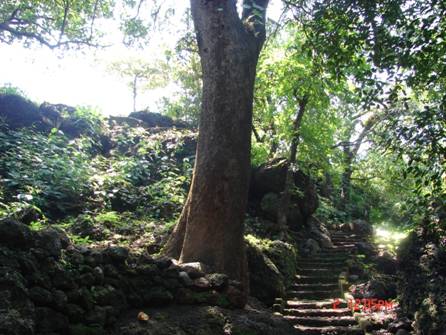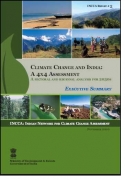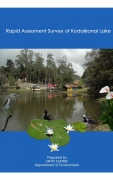/topics/wildlife
Wildlife
Sustainable water management initiatives in Konkan under threat - A report
Posted on 21 Jan, 2011 02:09 PMGuest Post by: Parineeta Dandekar
At the first sight, Daarche Paani (‘water at the doors’) appears unreal.. on a small flat plateau called ‘Sadaa’ in konkan, an elegant cobbled walkway leads a puzzled visitor to stairs carved in stone, which go down to an ancient grove, and here is an intricate system of tanks, channels and falls which supplies water to the Panderi village and goes down as a free flowing stream, to irrigate a plantation of arecanut, pepper and mangoes in a village called Gudaghe. When I visited the place, I could see three eminent visitors, a silent lady washing her load of clothes, a fairy bluebird splashing at a tank and a huge moonmoth in one of the trees.
 Stone walkway and ancient mango trees leading to Daarche Paani.
Stone walkway and ancient mango trees leading to Daarche Paani.
Photo: Parineeta Dandekar
Saltscapes - Dholavira, Gujarat - A guest post by Amitangshu Acharya and Ayan Ghosh
Posted on 27 Dec, 2010 11:41 PMGuest Post: Text by Amitangshu Acharya, Photographs by Ayan Ghosh
Kachchh – a brilliant halfway between a turmeric yellow Rajasthan and the emerald green Sahyadris – offers an upside down version of life. It tells you that seeds of life and civilisation are often hidden beneath the sands of time in inhospitable terrains.
Land acquisition for Renuka dam continues despite uncertainties - Press release from the Renuka Bandh Sangharsh Samiti
Posted on 21 Dec, 2010 12:24 PMForwarded to the portal by: Manshi Asher
Content Courtesy: Himvani
Author: Renuka Bandh Sangharsh Samiti
Despite protest against forced acquisition of land, Himachal Pradesh Power Corporation Limited (HPPCL) and revenue administration today notified Section 9 of the Land Acquisition Act 1894, for approximately 680 big has (about 57 hectares) of land of Panaar Village for the Renuka Dam Project. In a letter to the Chief Justice of Himachal Pradesh High Court sent today, activists appealed for a stay on land acquisition for the project, considering the uncertainty surrounding the project.
Himalayi Jan Goshnapatra: Himalayi Niti Ka Prarup – A report in Hindi by the Gandhi Peace Foundation
Posted on 18 Dec, 2010 08:19 AMThis document in Hindi prepared by the Gandhi Peace Foundation, is a blueprint of the Himalayan People's Manifesto. The manifesto has been brought out with the help of various documents prepared by various people and organisations at different times. It will be finalised by the next Himalayan Day on September 9, 2011.
Immediate moratorium sought on clearances for large dams in northeast India - Press release by Krishak Mukti Sangram Samiti (Assam)
Posted on 14 Dec, 2010 10:56 PM23rd November 2010, New Delhi
- Seeking a moratorium on clearances for large dams in Northeast India
- Withdrawal of clearances granted to 2000 MW Lower Subansiri, 1750 MW Demwe Lower & 1500 MW Tipaimukh dams
- Future steps on hydropower projects and dams only after full, prior and informed consent of people in the region
- Protect the Brahmaputra river basin as a cultural and ecological endowment
Wildlife Wetlands Photography Contest & Young Environmentalists Programme
Posted on 09 Dec, 2010 10:48 AMWildlife Wetlands Photography Contest by WWF & Young Environmentalists Programme in association with Meluha-The Ferns ecotel, Hiranandani Gardens Powai, Mumbai-400076 on 2nd February 2011.
World Wetlands Day Photography Submissions
A brand new photography international competition is here, the WWF & YEPT in association with Meluha-The Ferns ecotel awards celebrates and recognizes the talents of photographers of all nationalities highlighting the great wealth and diversity of wetlands and wildlife on Planet Earth.
Climate change and India - A sectoral and regional analysis for 2030s by the Indian Network for Climate Change Assessment (INCCA)
Posted on 05 Dec, 2010 10:45 AM This report prepared by the Indian Network for Climate Change Assessment (INCCA) provides an assessment of impact of climate change in 2030s on four key sectors of the Indian economy, namely agriculture, water, natural ecosystems & biodiversity and health in four climate sensitive regions of India, namely the Himalayan region, the Western Ghats, the Coastal Area and the North-East Region. This is the for the first time that such a comprehensive, long term assessment has been undertaken based on rigorous scientific analysis for the 2030s (all previous assessments were for the 2070s and beyond).
This report prepared by the Indian Network for Climate Change Assessment (INCCA) provides an assessment of impact of climate change in 2030s on four key sectors of the Indian economy, namely agriculture, water, natural ecosystems & biodiversity and health in four climate sensitive regions of India, namely the Himalayan region, the Western Ghats, the Coastal Area and the North-East Region. This is the for the first time that such a comprehensive, long term assessment has been undertaken based on rigorous scientific analysis for the 2030s (all previous assessments were for the 2070s and beyond).
News roundup (8-15 November 2010) :"India proposes a new emission check system" and News round-up on the floods
Posted on 17 Nov, 2010 06:08 PMClimate Change
Environment
Rapid assessment survey of Kodaikanal lake - ENVIS Centre (TN) (2009)
Posted on 02 Aug, 2010 02:02 AM This document by the Department of Environment, Government of Tamil Nadu highlights the importance of the Kodaikanal lake as an important tourist destination and warns that this freshwater lake is under the threat of getting polluted and its biodiversity endangered.
This document by the Department of Environment, Government of Tamil Nadu highlights the importance of the Kodaikanal lake as an important tourist destination and warns that this freshwater lake is under the threat of getting polluted and its biodiversity endangered.
The document presents the findings of the study that aimed at assessing the physico-chemical and biological quality of the Kodaikanal lake.
Evidence indicates that unrestricted tourism activities have led to high use of plastic bottles, glass bottles, plastic bags, causing high levels of pollution and silting of the lake. Damaged fibreglass boats left inside the lakes also pose a serious threat to the lake ecosystem.
Salvaging and scapegoating: Slum evictions on Chennai’s waterways - EPW paper
Posted on 02 Aug, 2010 01:03 AMThe paper highlights the case of recent projects that have been planned on the river Cooum in Chennai.





